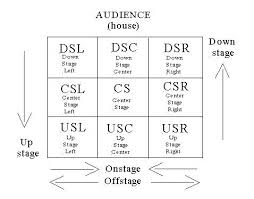You’re standing in the middle of an empty stage, nervously waiting for day one of rehearsals to begin. You’ve read the play, maybe had a chance to sit and read it with the other people involved with the show. But today is the first time you will be moving around on the actual stage.
Do you have your script? Good. Do you have a pencil with an eraser? Good.
Get ready for your blocking.
No, not mental blocking. Blocking is the activity in which people are directed to move on the stage in a regular, repeatable pattern.
One of the first things you have to know in order to go to the right place is where “north, south, east and west” are on a stage.
Moving downstage is moving towards the audience and moving upstage is moving away from the audience..
Why?
One story is that, back in the “old days,” the audience sat on a flat floor, not on a tilted one like you find today in a movie theater. In order that everyone could see what was going on, on the stage, the stage itself was slightly tilted towards the audience.
Therefore, walking towards the audience was literally walking downhill. Down the stage. Shortened to downstage.
Uphill was the opposite. It was heading away from the audience to a higher level on the tilt. So going away from the audience is known as going upstage.
The problems of working on a tilted stage are obvious and numerous. Items would slide of the stage into the laps of the audience. Balance was more difficult. And walking for hours on a slant was hard on feet, knees, back – the entire body!
Quickly, as the size of the audience grew, theater construction plans adjusted so that the stage was flat and the audience sat in tiers, at a tilt, in order to see the stage. But the name for the stage directions stayed.
Left and right are a little more difficult to remember, but only if you are not on stage facing the audience. These directions are given in your perspective as an actor on stage. In other words, as you stand on the stage and look in front of you at the audience, left is on your left and right is on your right. If the person telling you where to move says “Move two steps stage left” you take two steps left. “Exit stage right” means turn right and leave!
Easy.
Of course, it is more of a problem for the person who is sitting in the audience telling you which way to go – he or she must reverse their own perspective to fit with yours. The directions are always given to match the point of view of an actor facing the audience.
Center stage is the middle of the stage. The house is where the audience sits.
This diagram shows the directions on a stage, from the point of view of the actor facing the audience.

